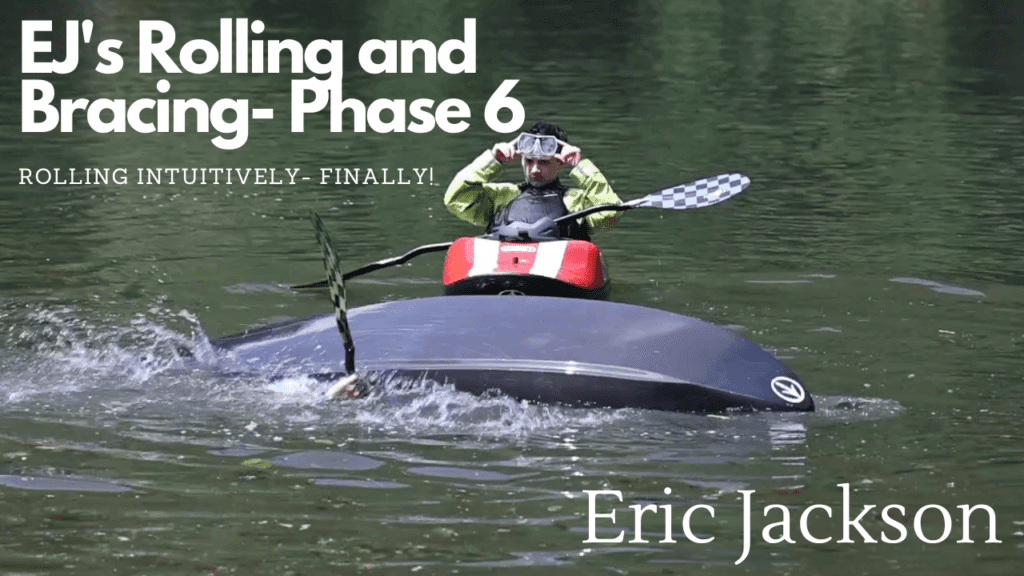Phase 6: The “Intuitive Roll”- roll from any position without going to home base. Most kayakers never try to get to this stage in their roll, which is too bad, because it is fun, and a logical next step, and also safer and more effective, if you get there. If you remember my definition of a good and great roll: Good Roll – “Roll first-time, every-time”. Great Roll – “Roll first-time, every time, really fast.” Notice that nowhere in the definitions do I prescribe a specific position for your boat, paddle, head, or body. The reason for this is that if you can roll up every time on your first attempt, you are achieving the goal for the roll – get right side up without failing. If you are doing that quickly, you are achieving the second goal of spending as little time upside down as possible when you do tip over. How long does it take, on average, for you to set your paddle up to home base after you tip over? It takes 3 seconds, on average. What if you just skip the home base position and roll from anywhere you can get a purchase on the paddle? I haven’t gone to home base when I roll up more than a few times in the past 30 years. Why? Because I like to roll up faster than that. What does an intuitive roll look like? It looks like the kayaker just “pops up” without setting up, which is what is happening. You actually learned to roll without setting up before you learned to roll from home base. Phase 3 is where you did that. You tipped over with your paddle off to one side, and when you hit the water, you pulled on your paddle and hip-snapped back up. This was way faster than after you learned Phase 4 and 5! Of course, you are not always going to tip over with your paddle in a position that is good for rolling up in. You will still need to move it to where you have enough purchase on the water to do the hip-snap.
- Phase 3 Drill: How much purchase do you need to roll up? Try this drill: Do a phase 3 roll with the paddle on the surface of the water, flop over, roll up.Repeat, but this time start with your paddle down under the water by 12”.Repeat again at 2” and keep going deeper until you can no longer hip-snap up. Now you know how deep your paddle can be and still roll up, given your hip snap ability.With a good hip-snap you can roll with a dead vertical paddle! Learning “paddle dexterity” and ease of “flying” your paddle where you want it underwater. Your paddle slices through the water nicely on edge, but it is hard to push the paddle through the water with the flat blade pushing water. It is time to learn to “fly” it underwater into whatever position you want. Paddle Dexterity Drill 1: Tip over and slice your paddle to the bow, then to the stern, and repeat as many times are you are comfortable under water. Ideally have your eyes open and watch your paddle blade hit the bow, then hit the stern (you won’t be able to see it hit the stern, but you want watch it go generally in the right direction)Use your right wrist/hand to twist the paddle and fly it along different paths to get to the bow and stern. Get comfortable with the idea of slicing the paddle where you want it to go. Phase 6 and Paddle Dexterity Drill 2: Tip over and slice your paddle to roll position from different starting points without going to home base first. Remember that roll position is straight out away from the boat, paddle shaft perpendicular to the boat, and at least as close to the surface as you have been able to successfully roll from (your phase 3 drill).Tip over with your right paddle blade deep in the water. Slice (feather) it up from deep to the roll position, and then hip-snap up (try the left).Tip over with your right paddle blade near the surface and near the stern. Now, slice the right blade from behind you to the roll position and hip-snap up (try on the left).Finally – tip over with the right paddle blade near the bow, but not on the surface of the water. Slice it backwards, while sculling it up until you hit roll position and then hip-snap up (try on the left).
Congratulations! You can move your paddle into roll position from anywhere and skip home base if you want to! Why should this be exciting if you are making it work? Because if you can cut three seconds off of your underwater time on average from 4-5 seconds to 1-2 seconds you are cutting your chances of hitting something underwater by 50-75% assuming you are rolling up with the same percentage of success. You are also not drifting upside down, out of control as far when you flip over. Awesome!

